Medical Disclaimer:
This article is for informational purposes only and does not replace professional veterinary advice. Always consult your veterinarian for diagnosis, treatment, and recommendations tailored to your pet’s specific needs.
Table of Contents
Introduction
Is your dog constantly scratching, chewing, or biting around the tail base, belly, or lower back yet you don’t see any fleas? That could be a telltale sign of flea allergy dermatitis (FAD), one of the most frustrating and misunderstood causes of canine itching. As a practicing small-animal vet in Ottawa, I’ve seen countless dogs suffer from this severe immune reaction to flea saliva. Even a single flea bite can send an allergic dog into a full-blown itch spiral, leading to red, inflamed skin and hair loss.
In this guide, I’ll walk you through what flea allergy dermatitis really looks like, how vets diagnose it, and most importantly how to get your dog fast relief and prevent future flare-ups. Using current research and clinical experience, you’ll find practical, vet-approved strategies that truly make a difference.
✅ Key Takeaways
- Flea allergy dermatitis (FAD) is caused by an allergic reaction to flea saliva not the flea itself. Even one bite can trigger intense itching.
- Common signs include constant scratching, red skin, hair loss, and crusty lesions especially on the tail base, back, and thighs.
- Diagnosis doesn’t always rely on finding fleas; pattern recognition and exclusion of other allergies are key.
- Effective treatment includes fast-acting flea control, anti-itch medications, and treating any secondary skin infections.
- Long-term success depends on consistent flea prevention, owner education, and regular veterinary follow-up.
- A comprehensive flea control plan should involve treating all pets in the home and the environment not just the itchy dog.
- Dogs with flea allergy dermatitis often benefit from oral isoxazolines, medicated baths, omega-3 supplements, and occasional corticosteroids.
What Is Flea Allergy Dermatitis?
Also see: https://doglifeexpert.com/7-ways-to-ease-seasonal-allergies-in-dogs/
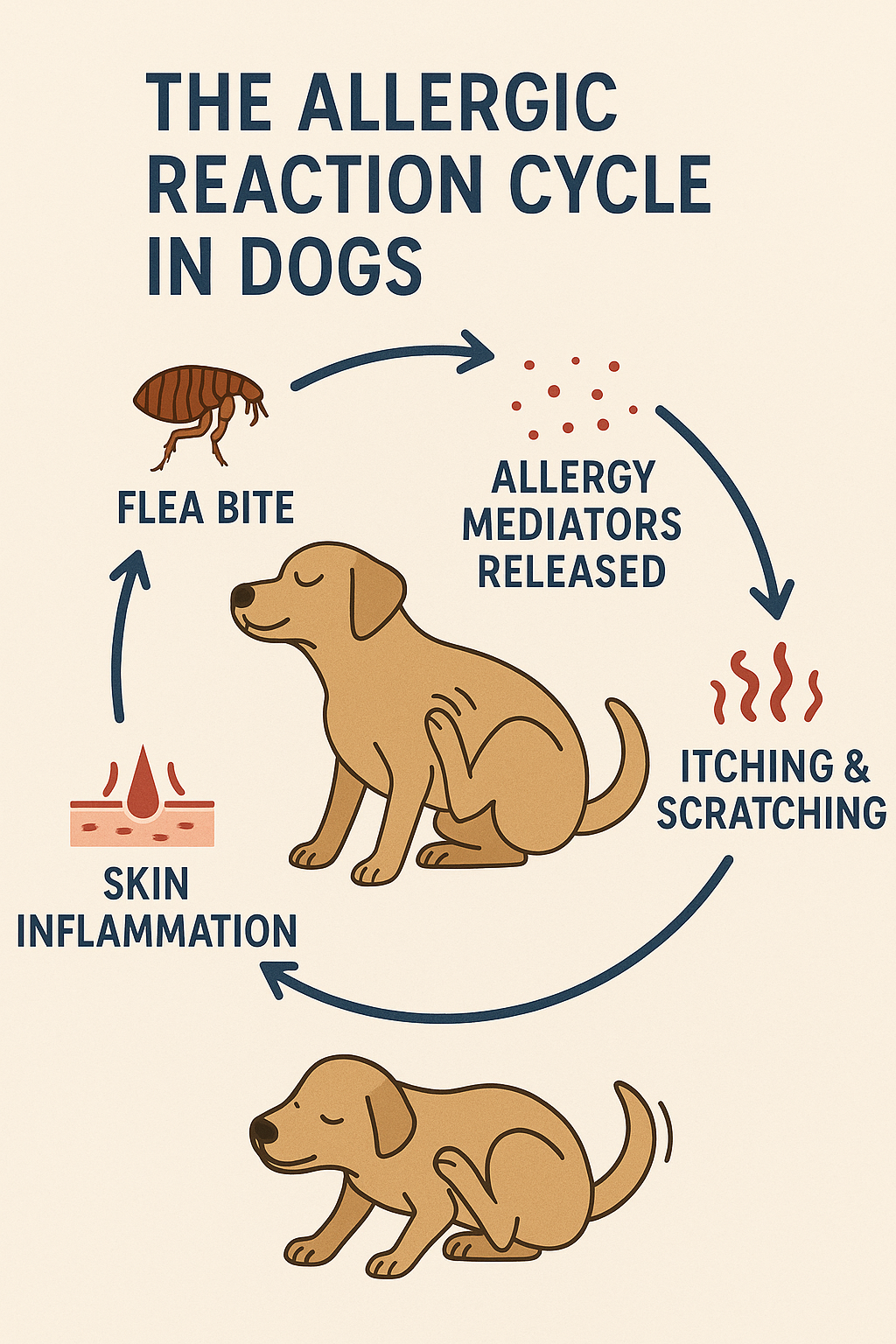
What Causes Flea Allergy Dermatitis?
Flea allergy dermatitis is an allergic skin disease triggered by proteins found in flea saliva. When a flea bites, it injects saliva into the skin, which can provoke an exaggerated immune response in sensitive dogs. This condition is the most common type of canine dermatitis, especially in temperate regions like Canada, where flea populations spike in spring through fall.
While most dogs will react to flea bites with minor irritation, those with flea-bite allergy develop intense pruritus (itchiness), leading to excessive scratching, chewing, and skin damage. In fact, dogs with FAD can have severe reactions to just one or two flea bites, according to the Merck Veterinary Manual (source).
The allergens in flea saliva mainly peptides and histamine-like compounds are what provoke this hypersensitive reaction. These are classified as Type I and Type IV hypersensitivity reactions, involving both immediate inflammation and delayed immune responses.
Immune Reactions Explained
Research from Kansas State University explains that dogs repeatedly exposed to fleas may develop a form of immunotolerance, meaning their immune systems become less reactive over time. Ironically, dogs with episodic or seasonal exposure like those that only get fleas during warmer months are more likely to develop severe symptoms due to a heightened flea saliva allergy (K-State Study).
This paradox helps explain why some dogs show terrible symptoms despite owners never seeing fleas. These dogs may be reacting not to flea numbers, but to immune memory and high levels of flea-specific IgE antibodies triggered by even minor exposure.
What Are the Signs of FAD in Dogs?
The hallmark symptom of flea allergy dermatitis is severe, localized itching, especially near:
- The tail base
- Lower back and hindquarters
- Thighs and groin
- Belly (ventral abdomen)
- The neck, ears, and sometimes the flanks
Initially, you may see papules (small red bumps), followed by self-trauma: dogs biting and scratching themselves to the point of bleeding. Over time, you’ll often notice:
- Hair loss
- Crusty scabs
- Thickened, darkened skin (lichenification and hyperpigmentation)
- Hot spots
- Secondary bacterial or yeast infections
These signs usually appear in a symmetrical distribution, which helps differentiate FAD from other types of canine dermatitis, such as food allergies or atopic dermatitis.
How Vets Diagnose Flea Allergy Dermatitis
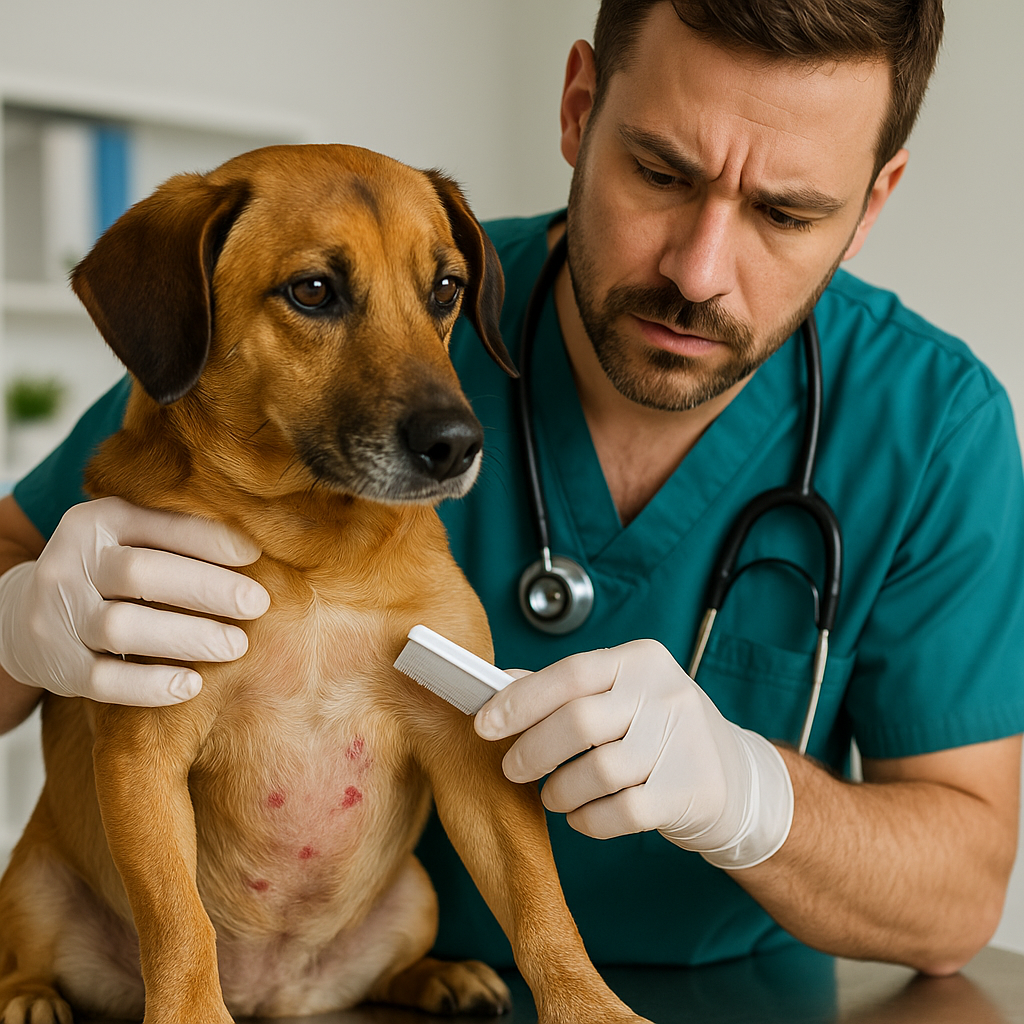
Clinical Diagnosis
Diagnosing flea allergy dermatitis doesn’t always involve finding fleas. In my Ottawa practice, many dogs I diagnose with FAD have no visible fleas or flea dirt at all. This is because dogs with FAD are so sensitive, they often groom away the evidence before you can spot it. Instead, we look for hallmark lesion patterns and ask detailed questions about symptoms and seasonality.
Veterinarians often make a presumptive diagnosis based on:
- Location of lesions (tail base, thighs, groin)
- Seasonal timing (especially late spring to early fall)
- Rapid response to flea control treatments
- History of other pets in the home or recent flea exposure
This approach is supported by the MSD Veterinary Manual, which states that diagnosis is frequently made clinically, based on distribution of lesions and patient history (source).
Diagnostic Testing Options
For more conclusive diagnosis especially when symptoms are persistent vets may recommend allergy testing. The two main options are:
- Intradermal skin testing: The gold standard for identifying flea saliva allergy, this involves injecting small amounts of flea antigen into the skin and observing for reactions. It’s accurate but not widely available in general practice.
- Serologic (IgE) ELISA tests: These measure flea-specific antibodies in your dog’s blood. They’re less accurate than skin tests, with specificity around 53%, but are more accessible and still clinically useful.
Some veterinary dermatologists may also conduct flea challenge tests intentionally exposing the dog to fleas in a controlled environment to observe reactions. However, this method is typically limited to research settings and not practical for most clinics.
Why Fleas May Be “Invisible”
It’s important to understand that the presence of fleas isn’t necessary for diagnosis. Dogs with flea allergy dermatitis often self-groom so aggressively that fleas and eggs are removed before owners ever notice them. Additionally, if your dog spends time outdoors, even a single bite from a transient flea can trigger a major flare-up of pruritus due to the hypersensitive immune response.
For this reason, many veterinarians use a therapeutic trial placing the dog on rigorous flea control and watching for improvement. If symptoms improve with flea treatment alone, that’s strong diagnostic evidence of flea-bite allergy.
Vet-Approved Treatments for Flea Allergy Dermatitis

Once your dog has been diagnosed with flea allergy dermatitis, treatment must be twofold: eliminating fleas completely and managing the allergic symptoms. A short-term solution won’t work dogs with FAD need long-term flea control and regular veterinary monitoring.
1. Kill Fleas on the Dog and in the Home
First and foremost, all fleas must be eliminated from your dog, your home, and other pets. If even one adult flea survives, it can bite and trigger another immune reaction. Start with a fast-acting oral adulticide and follow up with environmental treatment.
Key steps include:
- Use a prescription oral flea treatment like afoxolaner, fluralaner, or sarolaner to kill adult fleas quickly. These isoxazoline drugs are safe and highly effective (AAHA Guidelines).
- Vacuum all carpets, upholstery, and floors daily for at least a week.
- Wash all pet bedding in hot water and dry thoroughly.
- Treat all pets in the household with the same flea preventive to stop reinfestation.
- Consider environmental sprays or foggers containing insect growth regulators (IGRs) to prevent eggs and larvae from maturing.
2. Use Long-Term Flea Preventives
Dogs with flea allergy dermatitis need to be on a year-round flea control program not just during “flea season.” Even indoor-only dogs are at risk if fleas hitchhike into your home on shoes or clothing.
Recommended preventives include:
- Bravecto (fluralaner): lasts 12 weeks
- NexGard (afoxolaner): monthly chew
- Simparica (sarolaner): monthly chew
- Advantage Multi or Revolution Plus: topical monthly options that also prevent heartworm
According to the Merck Veterinary Manual, consistent use of adulticides is crucial to control FAD (source).
3. Manage Itching and Inflammation
Even with perfect flea control, your dog may still itch during the initial healing phase. Anti-inflammatory treatments provide essential itch relief while the allergic skin calms down.
Vet-recommended options include:
- Short-term corticosteroids (e.g., prednisone, dexamethasone) to suppress inflammation and reduce intense scratching.
- Apoquel (oclacitinib): a non-steroidal option that targets itch pathways and is safe for long-term use.
- Cytopoint (lokivetmab): an injectable monoclonal antibody that reduces pruritus in allergic dogs.
- Antihistamines (e.g., diphenhydramine, cetirizine) may help mildly affected dogs but are less effective for FAD.
- Omega-3 fatty acid supplements, like fish oil, to support skin healing and reduce inflammation.
These treatments are usually prescribed in combination and tailored to your dog’s symptoms, age, and medical history.
4. Treat Secondary Infections
Chronic scratching damages the skin barrier, allowing bacteria (like Staphylococcus) and yeast (Malassezia) to proliferate. These infections cause further redness, odour, crusting, and discomfort.
Veterinary treatment may include:
- Topical antimicrobials: chlorhexidine shampoos, sprays, or mousses
- Oral antibiotics: for deep or widespread bacterial infections
- Antifungal medications: for yeast overgrowth
The MSD Veterinary Manual emphasizes that treating secondary infections is essential for full recovery (source).
5. Build a Preventive Care Plan
Long-term management of flea allergy dermatitis involves collaboration between the veterinarian and pet owner. Every dog is different factors like environment, breed, and coexisting allergies matter.
Effective plans include:
- Scheduled flea preventive reminders
- Monitoring for seasonal flare-ups
- Adjustments to medication based on skin health
- Regular vet visits every 6–12 months
In warmer provinces, like British Columbia or Ontario, fleas can remain active nearly year-round, making prevention even more crucial.
6. Educate and Involve Pet Owners
Many relapses in FAD cases are due to gaps in owner compliance. It’s vital to explain that flea preventives work by killing fleas not by repelling them and are safe for most dogs.
Common client concerns you should address:
- “I don’t see fleas” remind them that flea saliva allergy can flare with just one bite.
- “I’m worried about side effects” explain that adverse events with isoxazolines are rare, and uncontrolled FAD is far more harmful.
- “I treated once, why is he still itching?” stress that long-term, consistent prevention is essential.
Educational handouts and follow-up calls improve success rates dramatically (DVM360).
7. Monitor & Reassess Frequently
Lastly, monitor your dog closely and be ready to adjust the plan. Dogs with episodic exposure often show worse symptoms due to sensitized immune memory (K-State Study).
If your dog’s symptoms persist despite flea control:
- Recheck for compliance gaps or environmental reinfestation
- Test for co-existing allergies (e.g., dust mites, pollen)
- Consider allergy testing and immunotherapy (ASIT) through a veterinary dermatologist
Quick-Reference Summary Table
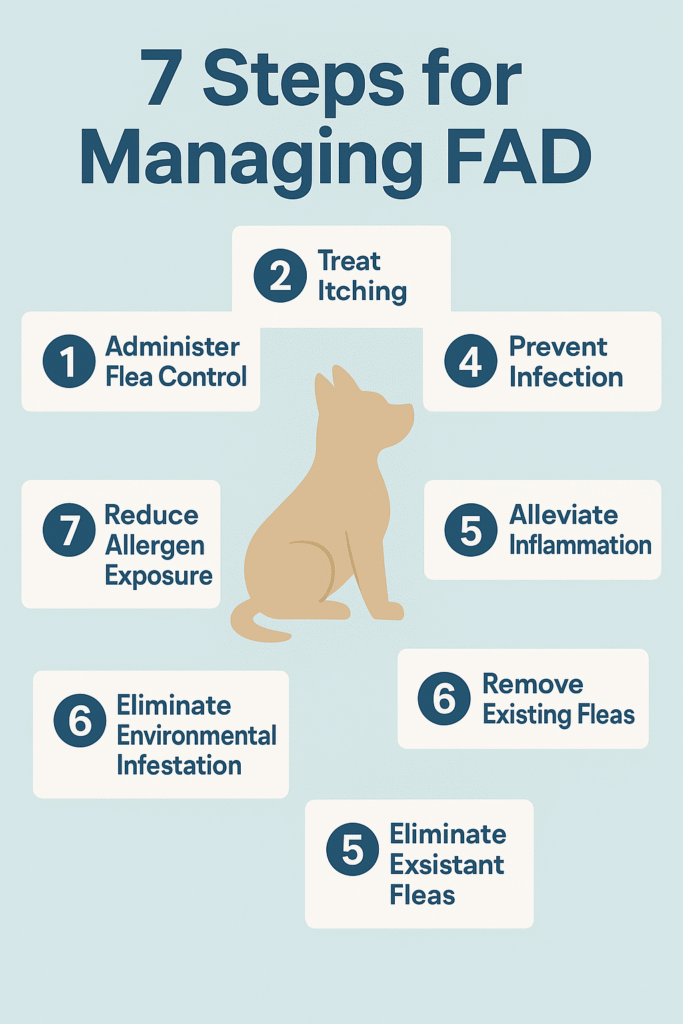
Here’s a practical table summarizing the core strategies for managing flea allergy dermatitis in dogs:
| Vet Tip | Action |
|---|---|
| 1. Flea Eradication | Treat dog, all pets, and environment thoroughly |
| 2. Long-Term Prevention | Use prescription adulticides (e.g., isoxazolines) monthly |
| 3. Anti-Itch Medications | Corticosteroids, Apoquel, Cytopoint, omega-3s |
| 4. Treat Infections | Topical or oral antibiotics and antifungals if needed |
| 5. Preventive Care Plan | Customize treatment based on climate, lifestyle, and breed |
| 6. Owner Education | Explain safety and necessity of ongoing flea protection |
| 7. Monitor & Adjust Plan | Track flare-ups; consider allergy testing if persistent |
This summary helps pet owners and veterinary teams stay on track when addressing flea allergy dermatitis, from immediate relief to long-term success.
Home Checklist: What You Can Do in 5 Minutes
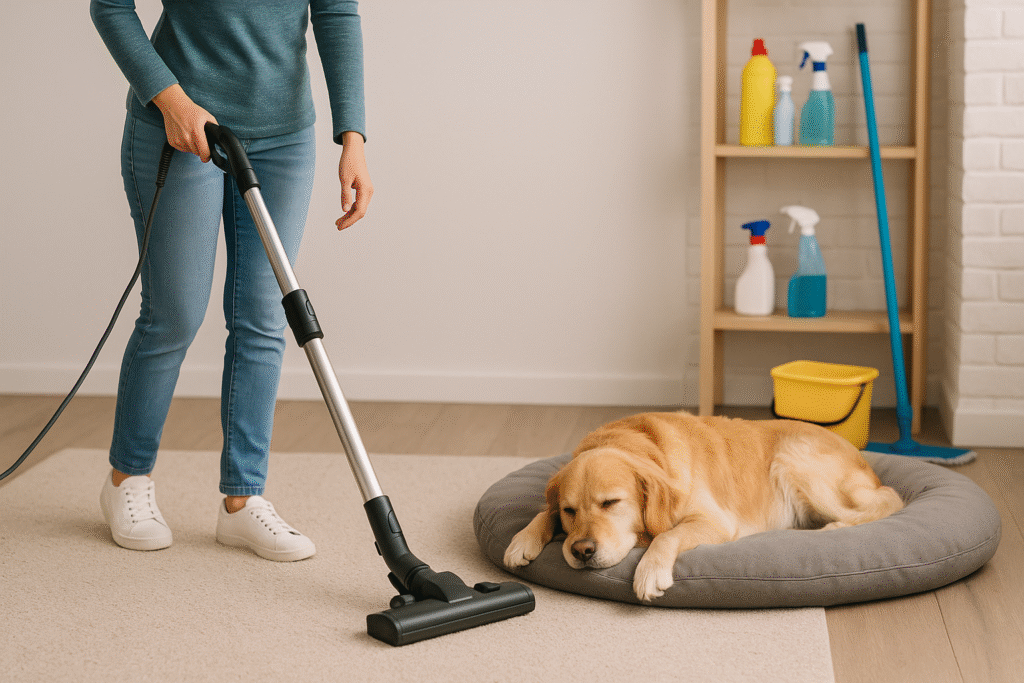
If you suspect flea allergy dermatitis, here’s a quick 5-minute action plan to help your dog right away before even visiting your vet:
Inspect common areas: Look at the tail base, belly, and thighs for redness, bumps, or scabbing classic signs of flea-bite allergy.
Use a flea comb: Check for flea dirt (tiny black specks that turn reddish when wet). Finding this confirms flea exposure.
Vacuum key zones: Focus on areas where your dog sleeps or lounges. Even 5 minutes of vacuuming can remove eggs and larvae.
Bag the vacuum contents: Flea eggs can hatch inside your vacuum empty the bag immediately and seal it tightly.
Wash your dog’s bedding: Hot water kills fleas in all life stages. Include sofa covers, car blankets, and pet beds.
Check your calendar: When was your last flea preventive dose? If more than 4 weeks ago, your dog may be unprotected.
Document symptoms: Snap photos of the skin and note when symptoms started. This helps your vet track patterns.
Small steps like these make a big difference in both diagnosis and flea allergy dermatitis prevention.
Typical Cost of Treating FAD in Canada
Managing flea allergy dermatitis can vary in cost depending on the severity, your location, and whether complications like skin infections are present. Here’s a breakdown of typical Canadian costs (in CAD) for veterinary treatment:
| Service or Product | Estimated Cost (CAD) |
|---|---|
| Vet consultation (initial exam) | $90 – $150 |
| Flea preventive (1–3 months supply) | $60 – $140 |
| Cytopoint injection | $90 – $160 per injection |
| Apoquel (30-day supply) | $90 – $130 |
| Antibiotics or antifungals | $45 – $120 |
| Medicated shampoo | $20 – $40 |
| Allergy testing (intradermal or blood) | $300 – $600 |
| Recheck exams | $60 – $90 per visit |
Note: Prices can vary widely depending on region and vet clinic. Some clinics offer flea prevention packages that may help reduce ongoing costs.
Investing in flea allergy control early often prevents costlier complications like chronic infections or emergency visits for severe flare-ups.
Prevention Tips for Flea Allergy Dermatitis

Preventing flea allergy dermatitis is far more effective and less stressful than treating recurring flare-ups. Here are essential prevention strategies based on real-world experience and current veterinary guidelines:
1. Use Year-Round Flea Prevention
Even in colder climates like Canada, fleas can survive indoors through winter. Keeping your dog on monthly flea control (like NexGard or Bravecto) is non-negotiable for dogs with FAD. Missed doses are one of the most common reasons for flare-ups.
2. Treat All Pets in the Household
Fleas easily jump between animals. If one pet carries fleas, your allergic dog will continue reacting even if you don’t see signs on the others. Always treat cats, dogs, and any indoor/outdoor pets with appropriate flea preventives.
3. Maintain a Clean Home Environment
- Vacuum carpets, baseboards, and furniture regularly.
- Wash all bedding weekly in hot water.
- Use flea sprays or powders in high-risk areas (but avoid toxic products).
Environmental management helps prevent immature flea stages from developing.
4. Use Flea-Repelling Outdoor Strategies
- Keep lawns mowed and shaded areas dry.
- Limit wildlife visitors that may carry fleas (e.g., raccoons, squirrels).
- Consider applying nematodes to soil these are beneficial organisms that kill flea larvae.
5. Monitor for Seasonal Flare-Ups
Keep a log of your dog’s symptoms and flare-ups. If your dog worsens during spring or fall, you may need to increase your vigilance during those months with extra baths or vet check-ins.
By staying consistent, dog owners can often eliminate new outbreaks of flea allergy dermatitis before they start.
FAQs: People Also Ask
How do I know if my dog has flea allergy dermatitis?
If your dog is obsessively scratching their tail base, groin, or lower back even without visible fleas they may have flea allergy dermatitis. Look for signs like hair loss, red scabs, or hot spots in these areas. A vet can confirm FAD based on lesion patterns and response to flea control.
Can flea allergy dermatitis happen even if I don’t see fleas?
Yes. Dogs with flea-bite allergy often groom fleas away before you notice them. Since it only takes one bite to trigger a severe reaction, you may never find fleas on your pet, but the immune system still goes into overdrive.
What flea medications work best for allergic dogs?
Veterinarians typically recommend oral isoxazoline products like NexGard, Simparica, or Bravecto. These kill adult fleas rapidly and are safe for long-term use in dogs with flea allergy dermatitis.
Can FAD be cured completely?
No, but it can be well-managed. Once a dog develops flea saliva allergy, it’s usually lifelong. However, with consistent flea control, most dogs experience long-term itch relief and no visible symptoms.
Is immunotherapy effective for flea allergies?
While immunotherapy is more commonly used for environmental allergies, some dogs with combined sensitivities may benefit. Flea-specific immunotherapy is rare but may be considered if standard treatments fail, especially if the dog also has atopic dermatitis.
Do dogs outgrow flea allergies?
Unfortunately, no. Dogs do not typically outgrow flea allergy dermatitis. In fact, the reaction may worsen over time if flea exposure is not properly managed. Lifelong prevention is the key to avoiding flare-ups.
Final Thoughts: You Can Help Your Dog Feel Better
Living with flea allergy dermatitis doesn’t have to be a constant battle. With consistent flea prevention, owner education, and proper veterinary care, most dogs can enjoy long-term itch relief and a return to healthy, comfortable skin.
As a veterinarian, I’ve seen how fast a dog’s life can turn around once fleas are eliminated and skin inflammation is treated. I’ve also seen how recurring FAD can be when flea control lapses even briefly. The key is not just killing fleas once, but staying ahead of the cycle.
Here’s what I always tell pet owners:
- Stick to your flea prevention schedule year-round.
- Don’t wait for itching to return before treating again.
- Talk to your vet early if symptoms flare or worsen.
With a thoughtful, vet-led approach to flea allergy dermatitis, your dog can live itch-free without the frustration and suffering of untreated allergic skin disease.

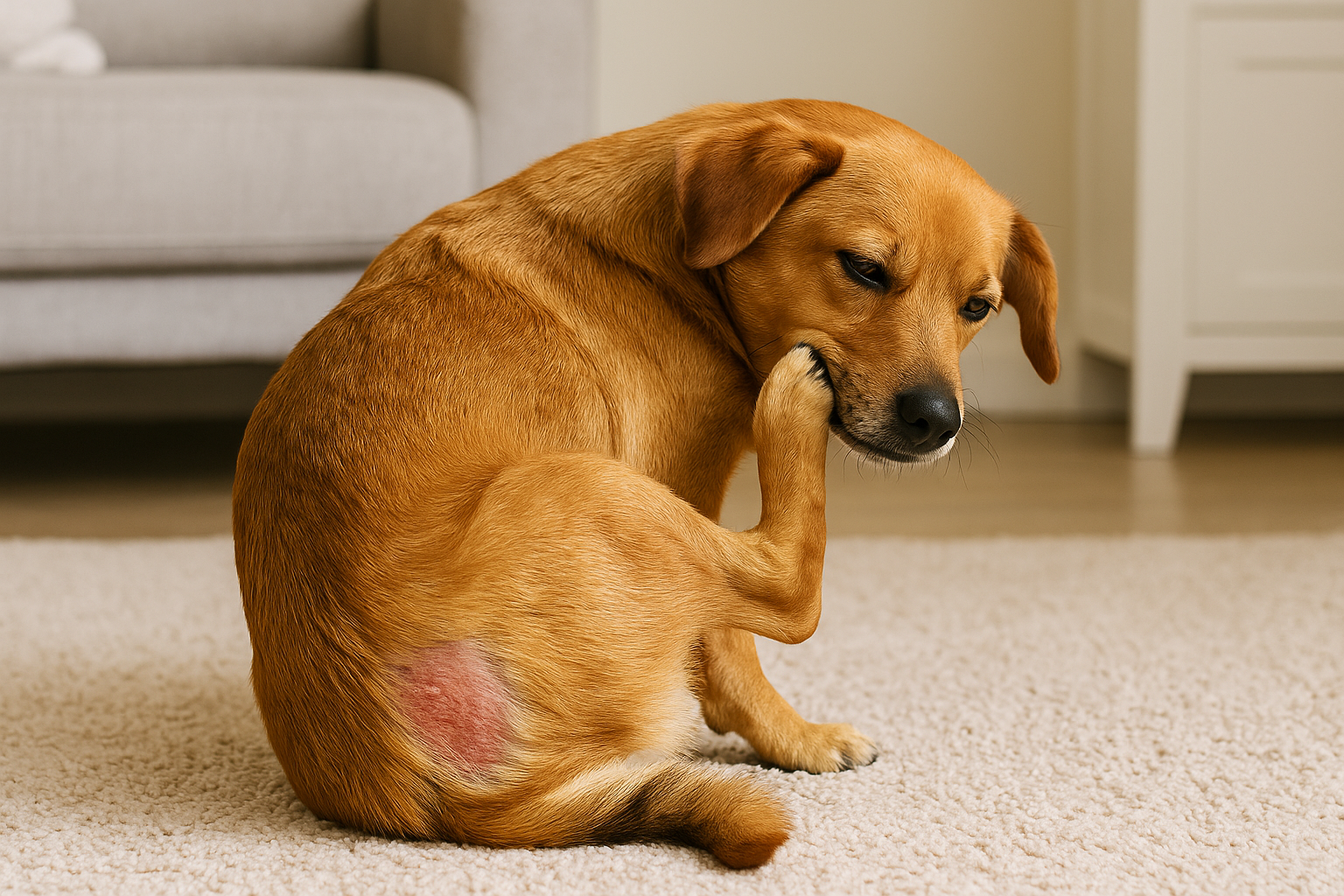


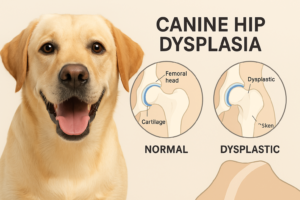
Pingback: Stop the Itch: 7 Natural Remedies for Dog Skin Allergies in 2025
Pingback: A Vet's Top 5 Tips for Flank Alopecia in Dogs